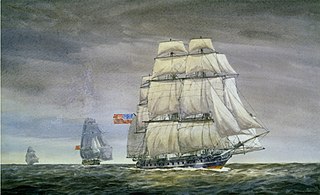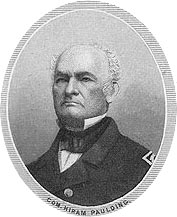
USS United States was a wooden-hulled, three-masted heavy frigate of the United States Navy and the first of the six original frigates authorized for construction by the Naval Act of 1794. The name "United States" was among ten names submitted to President George Washington by Secretary of War Timothy Pickering in March of 1795 for the frigates that were to be constructed. Joshua Humphreys designed the frigates to be the young Navy's capital ships, and so United States and her sisters were larger and more heavily armed and built than standard frigates of the period. She was built at Humphrey's shipyard in Philadelphia, Pennsylvania and launched on 10 May 1797 and immediately began duties with the newly formed United States Navy protecting American merchant shipping during the Quasi-War with France.

The fifth USS Boston was a protected cruiser and one of the first steel warships of the "New Navy" of the 1880s. In some references she is combined with Atlanta as the Atlanta class, in others as the Boston class.

USS Adams was a 28-gun (rated) sailing frigate of the United States Navy. She was laid down in 1797 at New York City by John Jackson and William Sheffield and launched on 8 June 1799. Captain Richard Valentine Morris took command of the ship.

USS Dolphin (PG-24) was a gunboat/dispatch vessel; the fourth ship of the United States Navy to share the name. Dolphin's keel was laid down by Delaware River Iron Ship Building and Engine Works of Chester, Pennsylvania. She was launched on 12 April 1884, with Captain George Dewey in command, and commissioned on 8 December 1885 with Captain R. W. Meade in command. Dolphin was the first Navy ship to fly the flag of the president of the United States during President Chester A. Arthur's administration, and the second Navy ship to serve as a presidential yacht.

USS Dale was a sloop-of-war in the United States Navy commissioned on 11 December 1839. Dale was involved in the Mexican–American War, the American Civil War, operations along Africa to suppress slave trade, and was used by the U.S. Revenue Cutter Service and later the U.S. Coast Guard, among other activities. Dale was placed into ordinary numerous times.

The third USS Hornet was a brig-rigged sloop-of-war in the United States Navy. During the War of 1812, she was the first U.S. Navy ship to capture a British privateer.

Daniel Ammen was a U.S. naval officer during the American Civil War and the postbellum period, as well as a prolific author. His last assignment in the Navy was Chief of the Bureau of Navigation.

Theodorus Bailey was a United States Navy officer during the American Civil War.

Hiram Paulding was a rear admiral in the United States Navy, who served from the War of 1812 until after the Civil War.

USS Flying Fish was formerly the New York City pilot boat schooner Independence. Purchased by the United States Navy at New York City on 3 August 1838 and upon joining her squadron in Hampton Roads on 12 August 1838, she was placed under command of Passed Midshipman S. R. Knox.

USS Guerriere was the first frigate built in the United States since 1801. The name came from a fast 38-gun British frigate captured and destroyed in a half-hour battle by USS Constitution on 19 August 1812. This victory was one of the United States' first in the War of 1812.

The first USS Shark was a schooner in the United States Navy. Built in the Washington Navy Yard to the designs of Henry Steers, Shark was launched on 17 May 1821. On 11 May 1821, Matthew C. Perry was ordered to take command of Shark, and the ship was ready to receive her crew on 2 June 1821.

The Pacific Squadron was part of the United States Navy squadron stationed in the Pacific Ocean in the 19th and early 20th centuries. Initially with no United States ports in the Pacific, they operated out of storeships which provided naval supplies and purchased food and obtained water from local ports of call in the Hawaiian Islands and towns on the Pacific Coast. Throughout the history of the Pacific Squadron, American ships fought against several enemies. Over one-half of the United States Navy would be sent to join the Pacific Squadron during the Mexican–American War. During the American Civil War, the squadron was reduced in size when its vessels were reassigned to Atlantic duty. When the Civil War was over, the squadron was reinforced again until being disbanded just after the turn of the 20th century.
The first USS Porpoise was a topsail schooner in the United States Navy.
USS Nonsuch was a moderately successful privateer built in 1812 and then an armed schooner in the United States Navy during the War of 1812. She was sold for breaking up in 1826.

Captain William Levereth Hudson, USN was a United States Navy officer in the first half of the 19th century.

The second USS Savannah was a frigate in the United States Navy. She was named after the city of Savannah, Georgia.
The whaler Globe, of Nantucket, Massachusetts, was launched in 1815. She made three whaling voyages and then in 1824, on her fourth, her crew mutinied, killing their officers. Eventually most of the mutineers were killed or captured and the vessel herself was back in Nantucket in her owners' hands. She continued to whale until about 1828. She was broken up circa 1830.

HMS Briton was a 38-gun fifth-rate frigate of the British Royal Navy's Leda class. She was ordered on 28 September 1808 and her keel laid down at Chatham Dockyard in February 1810. Navy veteran Sir Thomas Staines was appointed her first captain on 7 May 1812 but did not join the ship until 17 June 1813 owing to his being at sea aboard HMS Hamadryad. After a period of cruising in the Bay of Biscay, the vessel set sail for South America where during the course of several missions she unexpectedly encountered the last member of the crew that had seized HMS Bounty from its captain Lieutenant William Bligh during the 1789 mutiny aboard the ship. With the coming of the Pax Britannica in 1815, Briton undertook various voyages before she was broken up in 1860.















